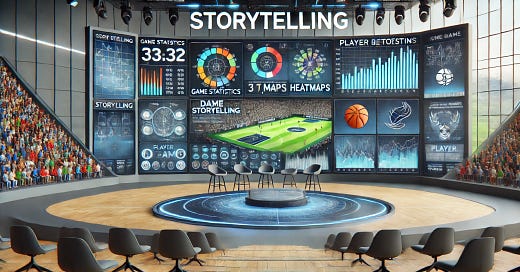From Data to Drama: Turning Insights into Stories Fans Care About
Jumping back in, one number at a time
Happy to be back after a good break!
Advanced stats have changed the way we watch sports. From win probabilities to shot charts, numbers now help us understand the game like never before. But stats alone aren’t enough. Fans don’t connect to spreadsheets—they connect to stories.
As someone who works with data, I’m often placed in the “data box.” People assume my focus is strictly on crunching numbers. But data is just one tool in my toolbox. Being a strategist means knowing how to use all the tools at your disposal—data, intuition, and creativity—to tell the stories that make fans feel something.
In my earlier blogs, I’ve touched on how advanced stats can create analysis paralysis (Analysis Paralysis: Simplifying Advanced Stats for Fans), how understanding fan behavior enhances strategy (Fan Behavior Modeling), and even how analytics are redefining partnerships (Sports Partnership Value).
Why Fans Love Stories, Not Spreadsheets
The moments that resonate most in sports are rarely about numbers alone.
Think about Steph Curry. His three-point shooting isn’t just a collection of stats; it’s a story about changing the way basketball is played.
Or consider the 2023 AFC Championship game between the Kansas City Chiefs and Cincinnati Bengals. A stat like Patrick Mahomes rushing for a critical first down late in the game might sound impressive. But it becomes unforgettable when you add the context: Mahomes was playing on a sprained ankle, leading his team to avenge a playoff loss to the Bengals the previous year. The numbers set the stage, but the story is what fans remember.
Stats come alive when they’re placed in context—when they reveal the human drama behind the numbers.
The Danger of Stats Without Context
Stats are everywhere today—on social media, in broadcasts, and even on scoreboards. But often, they’re used without the context that gives them meaning. How many times have you seen a viral stat that leaves out key details?
For example:
• A player is said to “break a record” but only because of changes in game rules or expanded schedules.
• A team’s “10-year drought against a rival” sounds dramatic until you realize they’ve only played twice in that time.
This isn’t a new problem—context has been a recurring theme in my writing. Whether it’s about simplifying advanced metrics or balancing analysis with action, I’ve often argued that stats shared without nuance can mislead fans and dilute their power.
We have a responsibility to provide context and insight. Fans deserve more than sensationalism—they deserve to understand the why behind the what.
Building Drama on a Foundation of Data
When used thoughtfully, stats don’t replace storytelling—they amplify it. Rivalries become more intense when we know the historical stakes. Underdogs become more inspiring when we see the odds they overcame.
This is why I see data as one tool among many. Numbers can shape the story, but they’re not the story itself. Being a strategist means knowing when to use data and when to lean on intuition, history, or even silence to let the moment speak for itself.
Where Do We Go from Here?
This blog is part of a larger conversation I’ve been building. If you’ve read my other pieces, you’ve seen how I approach advanced stats, fan interaction, and the business of sports. But there’s more to explore.
In future posts, I’ll dive into:
• How to simplify complex metrics without losing their meaning.
• The role of data storytelling across different media platforms.
At the end of the day, sports is about connection. Stats are powerful, but they’re only as meaningful as the stories they help us tell. Our job is to use every tool in the toolbox to connect with fans and create the moments they’ll remember long after the game is over.




